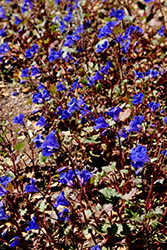It's all about ...
plants

Plant Height: 8 inches
Flower Height: 24 inches
Spread: 24 inches
Sunlight:
![]()
Hardiness Zone: (annual)
Other Names: Desert Bells, California Bluebell, Scorpion Weed
Description:
An annual desert wildflower featuring a loose, open habit and rounded, toothed, dark green leaves; a profusion of royal blue flowers appear in spring, then the plant sets seed for the next year; readily self sows, keeping its presence
Ornamental Features
Desert Bluebells features showy spikes of royal blue bell-shaped flowers with white anthers rising above the foliage from mid to late spring. Its serrated round leaves remain dark green in colour throughout the season. The burgundy stems are very colorful and add to the overall interest of the plant.
Landscape Attributes
Desert Bluebells is an open herbaceous annual with tall flower stalks held atop a low mound of foliage. Its medium texture blends into the garden, but can always be balanced by a couple of finer or coarser plants for an effective composition.
This is a relatively low maintenance plant, and should not require much pruning, except when necessary, such as to remove dieback. It is a good choice for attracting bees and butterflies to your yard. Gardeners should be aware of the following characteristic(s) that may warrant special consideration;
- Self-Seeding
Desert Bluebells is recommended for the following landscape applications;
- Mass Planting
- Rock/Alpine Gardens
- General Garden Use
- Groundcover
- Naturalizing And Woodland Gardens
Planting & Growing
Desert Bluebells will grow to be about 8 inches tall at maturity extending to 24 inches tall with the flowers, with a spread of 24 inches. This fast-growing annual will normally live for one full growing season, needing replacement the following year. However, this species tends to self-seed and may thereby endure for years in the garden if allowed.
This plant should only be grown in full sunlight. It prefers dry to average moisture levels with very well-drained soil, and will often die in standing water. It is considered to be drought-tolerant, and thus makes an ideal choice for a low-water garden or xeriscape application. It is not particular as to soil pH, but grows best in rich soils. It is somewhat tolerant of urban pollution. This species is native to parts of North America..
